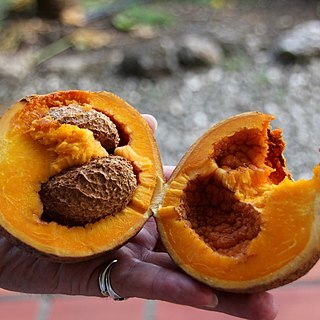Trees. Leaves opposite, petiolate, with numerous translucid dots and streaks in the areoles of the venation. Flowers polygamous, ♂ or hermaphrodite, the ♂ in axillary fascicles usually at already leafless nodes, the hermaphrodite flowers solitary, axillary. Calyx entire in bud, dividing into 2(–3) segments during anthesis, ± persistent. Petals 4(–5–6 or more), imbricate, deciduous. Stamens numerous, free or joined at the base into a continuous ring. Ovary 2-locular, with 2 ovules per locule, or sometimes 4-locular, with 1 ovule in each locule due to the formation of false septa; placentation basal; style very short; stigma peltate, 2–4-lobed; ovary absent or much reduced in male flowers. Fruit a drupe, usually 1-locular by abortion but sometimes 4-celled, with 1–4 fibrous or woody 1-seeded pyrenes. Seeds large, with indistinct cotyledons usually surrounded by a mostly colourless edible pulp.
Trees to 30 m high; polygamous-monoecious; plant ±glabrous. Twigs flattened, with prominently raised transverse ridges 3–5 mm apart. Leaves petiollate; petiole channelled; lamina coriaceous, elliptic, margins recurved, secondary veins raised, reticulate venation present. Inflorescences axillary or terminal, a cyme, fascicle or solitary flower, unbranched. Flowers pedicellate, 12–17 mm in diam., with distinct sepals and petals; sepals 2, completely enclosing flower bud, eventually splitting; petals 4, imbricate; stamens 150–200, basally connate; ovary subglobose or globose, 4-locular, 1ovule per locule, styles 2, connate. Fruit a drupe, indehiscent, calyx lobes persistent, style persistent, 1-seeded.
Trees, glabrous, without stilt or loop roots. Stems terete. Leaves: petiole caniculate, without adaxial protuberance; blade coriaceous, venation closely pinnate, without clear submarginal vein, with tertiary venation prominent between lateral veins, with glandular dots in areoles. Inflorescences fasciculate or flowers solitary; peduncle absent; bracts absent. Flowers bisexual or unisexual, stellate; sepals persistent, 2(or 3), completely connate in bud, splitting into 2 irregular valves; stamens not fascicled; style thick, very short. Fruits baccate; pericarp firm, rough. Seeds 2–4. x = 16.

